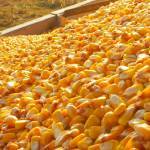Corn Analysis: What Strain Is Best for Horse Feed?

Research at University Teknologi MARA in Malaysia has turned up significant differences in the values for protein, gross energy, crude fiber, and nitrogen content among various strains of corn. Mass spectrometry was used to determine the micro- and macronutrient content of corn strains commonly used for both human foods and feeds for horses and other livestock.
Several varieties of corn were planted in one large plot so that soil parameters and climate would not be variables in the nutrient analysis. A Taiwanese strain of corn was found to be higher in crude protein and nitrogen but lower in gross energy and crude fiber than a strain originating in Korea. Differences were also found in amounts of aluminum, calcium, copper, iron, potassium, magnesium, sodium, phosphorus, sulfur, and zinc when the two strains were compared. Levels of various nutrients in both strains were acceptable for consumption by both humans and livestock.
No specific variety of corn is used in producing feeds for horses and other animals in Malaysia. With more study of different strains, it may be possible to increase growth and production by matching nutritive values to the requirements of horses and other livestock.








